The USMC's 'land shark'
Wheeled APCs and IFVs, fast and extremely versatile and modular, are a familiar sight now throughout the world's armies. The development of the LAV-25 looks like the start of a joke, with a Swiss, an American and a Canadian thrown into some odd situation. It is sobering to think that the LAV-25 was born at the same time as the Bradley and the Hummer, just when the Abrams M1A1 also made its debut. A brand new generation of American AFVs in this last decade of the cold war, marred with surprised, last-ditch tensions and complete with the grand finale: Total collapse of the Soviet Union and an unexpected war in the middle east where this new generation of AFVs was to be tested.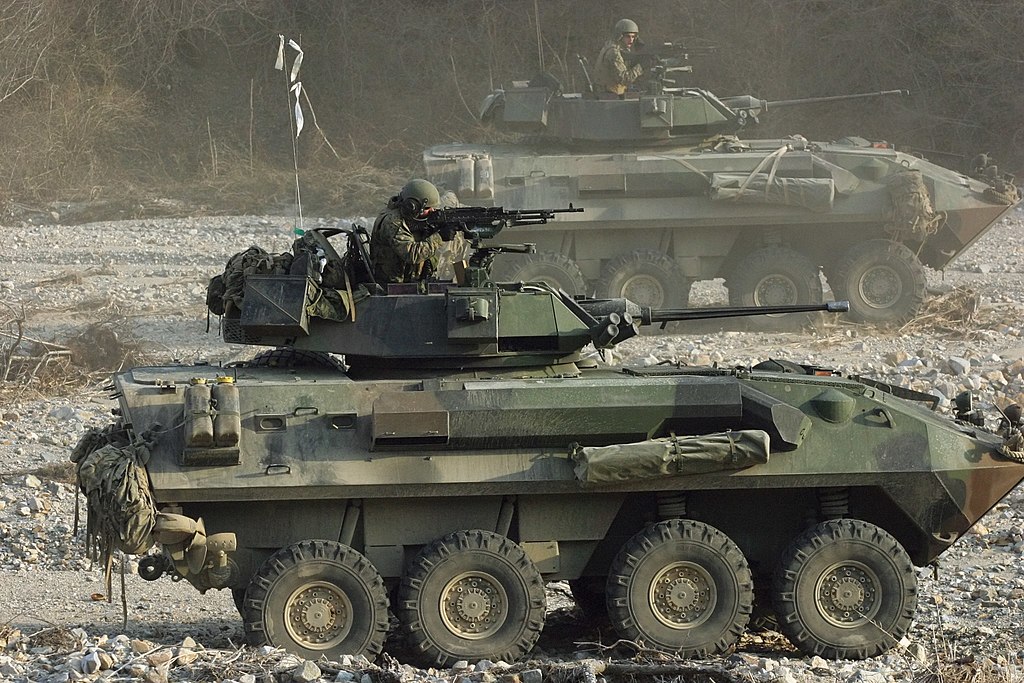
The LAV-25 name itself was not for the US Army but the USMC, which seeked a new fast transportation vehicle, faster in any case that what was at hand anyway, like the "fridges" true amphibious tracked monsters such as the LVTP-7 (Now AAV-7A1). It was to be amphibious as well, a well-understood requirement for amphibious assaults. Produced in Canada by GDLS, about 760 entered service, with several modifications and variants and by then, they were expected to stay in service until 2005. With the end of the cold war and budget reduction, this was prolongated to 2035, with a program or upgrade and overhauls in between (LAV-A2). The LAV-25 has been tested in combat during the Gulf War, also operated by the US Army.
Development of the LAV-25
In the US Nomenclature, "LAV" refers to Light Armored Vehicle", 25 referring to the calber of the main gun, a 25 mm M242 Chain Gun. In 1982, The pentagon requirement was met by several proposition, the most seducing one being GM Defense's own proposal. It was based on the project by Diesel Division, General Motors of Canada (Later General Dynamics Land Systems Canada), basically a 8x8 version of the locally produced AVGP 6x6 vehicles family, closely based on the Swiss Piranha I from 1977.
The LAV Program started in the 1970s already, when the Carter administration seeked to create the RDF or Rapid Deployment Force, later RTDF to answer any crisis (with the middle east in mind at that time). The LAV requirement was then first expressed for this unit. In the early 1980s, both the US Army and USMC agreed upon the acquisition of an "off the shelf" vehicle which ended with the April 1981 submission offered to 20 companies.
At the end of the competition Alvis Ltd, Cadillac Gage and the Diesel Division of GM Canada were selected, pressed to produce at least three test vehicles each, two with the 25 mm Bushmaster Chain gun and a single one with the Belgian 90 mm Cockerill gun. Alvis came with a 90 mm Scorpion version and three re-equiped Stormer APCs, Cadillac Gage with the V-300, a 6x6 commando derived from the V150S, but the only 8x8 vehicle was from GM Canada;
The US Army was already familiarized with the Mowag concept, testing Cougar and Grizzly in the FACT 1979 evaluation test. Tests for the three contender's vehicles took placeat Twentynine springs Cal. and Yuma in Arizona while the committee was headed by Maj. Gen. OC Decker Jr. for procurement and decision reffered to the MSARC with the assistant commandant of the USMC. The latter expected 744 vehicles, the Army 2,350. Trials started in late 1981 and ended in September 1982 with GM Canada as a clear winner. The LAV program by then also encompassed for a time the HMMWV and the LAV-25 8x8 was designated M1047 by the Army. The Army vehicle was to carry not troops but supplies instead. However the Army withdrew eventually, leaving the USMC sole beneficiary of the LAV program.

Integration into the USMC structure
The latter precised their requirements, with a regular IFV, the LAV-AT (antitank), LAV-L (Logistics), R for recovery, M for mortar and C2 for C&C (Command vehicle), with purchased voted FY 1982-85. The vehicles were all delivered plus 14. It created some floating inside the USMC doctrine and structure, as the LAV did not replaced any existing vehicle but were an addition that had to fit in. Therefore, LAV batallions (LAVB) were created around it, and in 1988, redesignated LAI (Light Armored Infantry) and in 1994 LAR (Light Armored Reconnaissance).Responsibility for constituting and training the new units fell onto the ITS (Infantry Training School) Camp Pendelton Cal., with a LAV branch in 1982. The training rose up to officer/sub-officer level in 1994 and in 2003 it became the LAV training Company (LAVTC), an independent school with three levels.
Design of the LAV-25
The hull is still very close to the original Swiss prismatic concept with light armor (in order to deflect and use the properties of artificial thickness by sloping), which was no more than 6 mm thick in welded armor steel plates, enough to top 7.62 m bullets (STANAG I). In addition anti-skid was added to the horizontal/near-horizontal surfaces for the crew to step on in cold, wet conditions. The hull was 6.39 m long overall for 2.5 m in width and 2.7 m in height, and a total weight in battle order of 12.7 tons;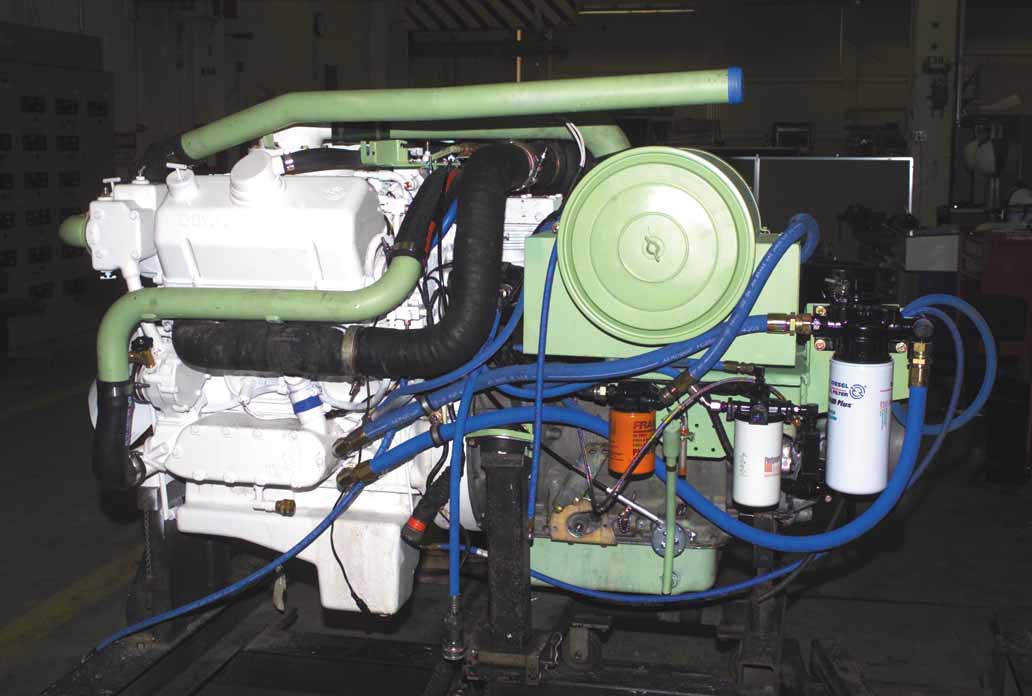
Propulsion
The beating hart of the LAV-25 is its Detroit Allison Turbocharged 6V53T, liquid-cooled two-stroke diesel engine rated for 275 hp, couped with an automatic transmission with 5 forwad, 1 reverse gear on 16 drive shafts for transfer of the eight independent wheels and a derivation for the two rear propellers. The driver's options included a 4x4 or 8x8 selected drive (for road/off road), lessening friction and consumption.Top speed was 100 kph as specficied on road, 60 kph on average off-road (62.2 mph). It had a 14.9 in ground clearance. Tires were Michelin XL 11x16in, mounted on tubeless steel beted radials. The suspensions comprised four torsion bars (behind each train) and eight schock absorbers. The steering controlled the four front wheels.

The LAV-25 was tested capable to climb a gradient of 60%, a side slope of 30%, a vertical step of 0.5 m and a trench 2 m wide. It was amphibious and the propellers allowed it to reach 10.4 km/h. Steering however was through cables controlling a rudder connnecting both propellers in coordination with the front road wheels. The hull was not tailored for prolongated water operations through. It lacked an efficient foldable trime vane but the beak was more prone to plow into waves rather than making the vehicle surf over at such speed. I can't find a source if it was tested at sea. Photos of Amphibious ops. only shows vehicles landing on the beach. The LAVs is amphibious with little preparation, in just 3 minutes. It can ford streams, rivers and inland waterways. It is also air-transportable by a C-130 Hercules, C-17 and larger, as well as carried underslung by the CH-53E heavy duty USMC Super Stallion helicopter. Para-dropping tests were also performed with success.Range on land was measured as 668 km with a balanced drive.
Protection
As stated above the overall protection was enough against small arms fire, completed by a thicker armor ad slope on the frontal arc, protecting against 12.7 mm rounds, and like the rest artillery shell splinters. Of course with time, upgraded versions received add-on armor, but still this was never on the level of the following US Army Stryker.
Armament
The LAV-25 was clearly an IFV, not an APC like the M113, since the carrying capacity was reduced to a half-platoon (6) while the crew ws made of three personal, driver, co-driver/commander and gunner, that can dismount if needed for advanced reconnaissance ahead of the vehicle. The driver was located on the left-front, nearby the engine (right compartment), while behind were located the gunner and commander inside the two-men turret. The driver was given a 180° field of view thanks to three M17 periscopes with the central one swapped for a night vision periscope. The gunner had a single night vision periscope to his left, thermal sight in front, and the commander a periscopic gun sight in front and seven M27 into the hatch for a 360 view. His video display also doubled the gunner's thermal sight view.
The infantry half-platoon was six in theory but practice of the USMC more often shows four men, but the space was used by supplies and additional equipment. These are Marine scouts, not a typical battle integrated platoon with specialists. They can see through two side vision blocks and hatches overhead. There is a safety mechanism when the men are standing up though the hatches to avoid the gun blasting over their heads. To exit, they used both doors aft. The driver has his own hatch and as the gunner and commander on top of the turret.
The main armament of the vehicle is its Chain gun M242 Busmaster 25 mm Cannon. Fully-automatic it was developed by McDonnell Douglas for aircrafts, and revised and adapted by Alliant Techsystem. It os composed of three assembly blocks: The barrel, feeder and receiver, parts which are light enough to be manipulated and maintained by the gunner. The entire gun can be removed easily. It has its own 1 hp electric power supply which drived the chain from the receiver. It is fully automatic, with an internal gas-opearing close-loop. There is also a manual backup.

The M242 weapons system is able to provide a sustained high rate of fire: 200 rpm. Low rate (extra cooling) is 100 rpm. Provision of standard NATO 25x137 mm rounds could be swapped by the gunner between AP and HE rounds, with a third rate of fire, single shot. The turret mount allows a 60° elevation and 8° depression. Top range is 11,000 yards but effective range is 1641 yards; Ammo turret supply consisting of 150 HE and 60 AP rounds (210 ready-rounds in belts), while 420 more can be stored inside the hull. There is also a coaxial 7.62 mm M240 standard MG with 400 rounds, and a supplementary 7.62 mm is pintle-mounted at the commander's roof position. For concealment, two M257 smoke dischargers groups are provided (45 yards) each with four L8A1 smoke grenades.
The turret is protected by sloped armor plates, providing overall protection against 7.62 mm rounds. The main gun is stabilized in elevation and transfer, with the coaxial, both are coupled for elevation to the same rotor. Smoke grenade dischargers left and right had their own selector, and eight spare grenades are stored inside the turret (external reloading). The roof periscope gun sight has is hinged for ballistic protection, and there is a head assembly for te gunner thermal sight. There is also a fold-down wire cutter above the main gun.
Variants
The regular program gives a total of 467 IFVs, 55 Command versions, 109 Logistic, 45 Recovery, 115 antitank, 60 Mortar, but supplementary units were built, along with additional variants when production was relauched until 2003, bringing the total to 12 MEWSS and 17 additional LV-ADs and grand total of 880 according to Jane's 2005-2006.
LAV-L logistic vehicle
The Light Armored Vehicle-Logistics (LAV-L) or LAV-LOG (Logistics) modified to carry ammunition, rations and POL (petroleum, oil and lubricant) on the battlefield, assiting forward LAV units. Like the regular LAV, this version is air transportable on the same carriers, starting with the C-130 and an be lifted by the CH-53 E. 200 ready rounds could be used on the onboard 7.62mm machine gun, 800 more stored. 8 Smoke grenades also also ready, with 8 more spare grenades. The LAV-L is also amphibious, with a 3 minutes preparation. 93 vehicles are in the inventory.LAV-R Recovery vehicle
The standard recovery vehicle able to help any LAV disabled vehicle and assimilated. It is fitted with a boom crane and a recovery winch. Itsdefensive armment is limited to a pintle-mounted M240E1/G 7.62 mm (0.3 cal.) machine gun with 1,000 rounds in store. Apparently it is also fitted with eight smoke dischargers. 45 were registered in service or inventory.LAV-C2 Command vehicle
The Light Armored Vehicle-Command and Control (C&C or C2) is the standard command vehicle attached to LAV units. The main rear compartment is modified with a map table, VHF, UHF and HF radios and satcom. It has a raised roof with a full communication stations for the Unit Commander to other vehocles of his unit and the liaison with upper echelons. For close defence the LAV-C2 is armed with a single M240E1/G 7,62 mm machine gun with 1,000 rounds. At 1995 cost, each of the vehicle is about 650,000 $ apiece.
LAV-T Antitank vehicle
Probably the deadliest version of the LAV, it is the organic antitank support of the mobile unit, outside the portable AT missile launchers carried by the platoon. The missiles can be fire from defiled positions against heavily armored target and fixed fortifications. It is capable of providing this anti-armor fire support to LAV units as well as reconnaissance forces, thanks to its great speed, its vectors ensuring a better range than portable weapons. It can be used is defensive and offensive roles. The weapon system TOW II ATGM is housed in the unmanned Emerson turret 901A1 launcher developed for the M901 ITV based on the M113.Combat loaded, 2 missiles are ready while 14 more are stowed, either wire-guided or radio frequency TOWs. In addition there is the 7.62 mm pintle-mounted M240E1 or M240B standard machine gun with 200 ready rounds and 800 stored and eight smoke dischargers. Like the other vehicles it is air-transportable and amphibious with minimal preparations.

The latest development is an upgrade called LAV-ATM (Modernization) (2012, deployed from 2017), fitted with Modified Target Acquisition System (MTAS) turret. It provide a fast-moving tracking and targeting system to fire an all terrains and on the move, together with a more reliable digital design. This includes an improved thermal sight, Far Target Location system, new commander and gunner video sight displays, and an electric elevation and azimuth system. 95 vehicles are registered in the USMC inventory at $1,252,000 unit replacement cost.
LAV-M Mortar vehicle
The LAV-M (For Mortar) provides indirect fire support to light infantry and reconnaissance forces. It is given opening doors on the top, leaving passage for the 81 mm M252 mortar. The latter is provided a rotatable mounts with 360° traverse. A bipod is also carried to dismount the mortar. In addition the LAV-M is protected by a standard pintle-mounted M240E1 machine gun (200 ready rounds, 800 in store). For concealment, eight smoke dischargers are provided. Provisions for the mortar are ninety-nine 81 mm mortar shells, high explosive, covering smoke or illumination types. 50 LAV-M are in the inventory at $667,000 apiece. The system was further developed into the LAV-EFSS (Expeditionary Fire Support System), a proposed replacement with the Dragon Fire system, a 120 mm recoil mortar system. It was never ordered.
LAV-AD (Air Defense)
The vehicle is fitted with an electric turret, mounting the General Dynamics GAU-12 Equalizer. This is a 25 mm (0.984 in) 5-barreled Gatling cannon. The armament is completed by two missile pods on each side, with four FIM-92 Stinger missiles for SHORAD (short range AA cover). The turret came with 990 rounds of 25 mm while 16 FIM-92 Stinger missiles are carried total, hald ready and the othger in stowage. A variant was tested with the French Mistral missile for export. But both were evaluated by the CCAC and failed to attract orders.LAV-AG assault gun
The Light Armored Vehicle-Assault Gun (LAV-AG) is developed for export (not in the USMC inventory). It was designed to carry a larger turret with a 90 mm cannon, providing direct fire with kinetic energy and chemical energy rounds. The MK8-90mm Main Gun is completed by an M240 7.62mm pintle-mounted Coaxial Machine Gun with an ancillary M2-50 cal Pintle Machine Gun and two M257 Smoke Grenade Launchers. The 90 mm gun is provided with 20 ready rounds and 20 more in stowage. The gun barrel is shown with a thermal sleeve and muzzle brake. Performances are said similar to the standard NATO Cockerill 90 mm. The APFSDS are able to penetrate the armor of most Soviet-era MBTs, from the T-54 to the T-72. The CCAC was given the task to evaluate the performance and safety of the entire system, but no order came.LAV MEWSS electronic warfare vehicle (1988)
It is a highly specialized LAV entirely modified to provide electronic warfare on the battlefield. The US Marines ordered 12 of these in 1987, delivered in 1989. Capabilities includes a mobile electronic warfare center, data collection, location and position of enemy force, as well as classic ECM by jamming enemy communications. It is also able to conduct lectronic attacks against specific targets, notably in the forward area of operations and in a variety of tactical situations.As for standard it is fylly compatible with US Army's mobile electronic warfare assets and can communicate and coordonate with similar vehicles of the Army. For self-defence, the vehicle possesses the same pintle-mounted 7.62 mm GPMG. Lately the model was upgraded to the PIP standard. Called "Product Improvement Program standard" it cmprised an upgraded sensor suite and a 9 m high extendible mast contains system antennas. Details of the current variant are classified.
Upgrade programs
LAST/CCA Protection upgrade (1991, 1998)
The first level of modifications concerned armor. Applique armor kits were developed to be added on the main hull, providing all-arond protection against 14.5mm rounds. Affterwards was introduced Composite Ceramic Armor kits, fielded in 1998. They provided protection against 20mm AP rounds. Yet the LAV-25 was not able to sustain same caliber rounds damage (25 mm) although the added armor provide some protection.LAV-A1/SLEP major upgrade (2003)
The vehicle has been through many changes through the late 1990s, and the entire range of modification was rationalized as SLEP, creating the LAV-25A1 standard for older unit to be retrofitted. The whole Service Life Extension Program started in 2000. It focused on providing some form of camouflage and improve the visual and thermal characteristics of the vehicle. Concretely, applique camouflage panels were added and modification were made to the engine exhaust to lower the infrared signature. The other change concerned reliability, by providing the vehicles enhanced corrosion resistance, and replacing the entire electronics systems. The driver also benefited from an innovation, with a heads-up display.
LAV-A2 program (2006)
The second round of improvements was performed while SLEP was completed. It consisted not in an immediate upgrade but first to produce 125 brand new vehicles testing the second modernization standard, to be later applied to all A1 vehicles in service. The A2 was largely driven by the lessons learnt in Iraq and Afghanistan. They were provided with a three-tier applique armor suite to sustain damage from IEDs and portable kinetic energy penetrators. Internal protection was improved with a new, faster automatic fire suppression system, completed by the replacement of the turret's hydraulic circuits by electric ones to mitigate the risk of fire.Also the crew was better protected by the an anti-spall lining developed for the Army's LAV-III Stryker. Both the internal and external ballistic protection ws developed by Armatec Survivability. Also the commander and gunner were given the new Thermal Sight System (ITSS) developed by Raytheon. It includes an eye-safe laser range finder coupled to a fire-control solution, and far-target location grid information display.
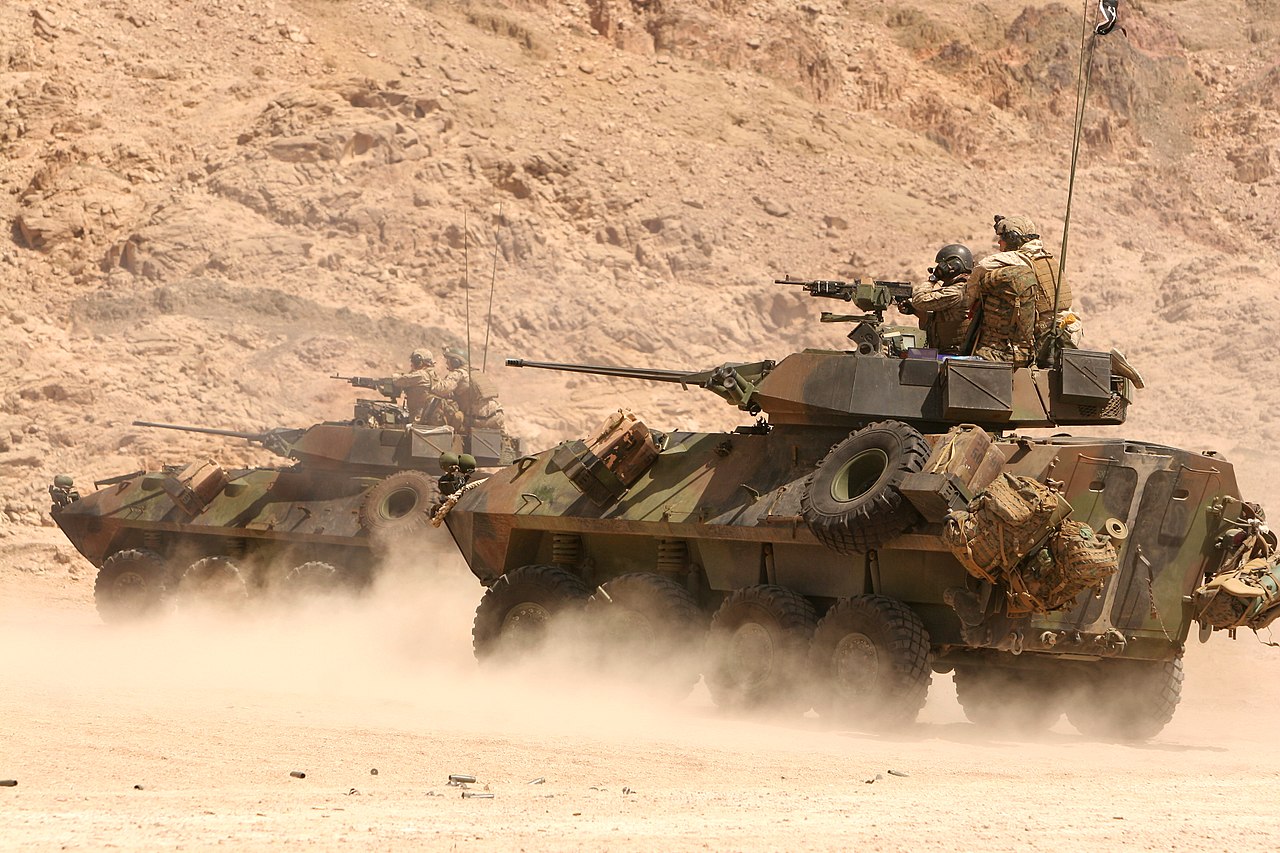
However these changes badly impacted the overall weight, which imposed the replacement of the entire wheeltrain, suspension and torsion bars, shock absorbers, struts and steering knuckles, and drive shafts. Officially the new A2 entered service in October 2007 and retrofittings to the new standard proceeded.
Also the main gun underwent an upgrade programmed FY2007-2010, called the LAV Lethality Program. The M242 gun and associated hardware and software were upgraded to enable firing the new M919 25 mm Armor Piercing, Fin Stabilized, Discarding Sabot (with Depleted Uranium) or APFSDS(U) with tracer ammunition. Large part of this gun upgrades are shaded with the U.S. Army's Bradley Fighting Vehicle.
The A2 was tested by the Army, the Operational Test Command (OTC), Airborne and Special Operations Test Directorate at Fort Bragg. On 26 October 2018, the Alpha Company, 4th Battalion, 68th Armor Regiment, 1st Brigade Combat Team of the 82nd Airborne Division tested successfully the vehicles in an airborne operation.
LAV-A3 program (2019)
General Dynamics was awarded the $37.2 million contract of modernizing the whole LAV fleet in January. The current upgrade consists in improving the powerpack's reliability, cooling capacity, auto-diagnostics and fuel consumption. Not a luxury after the A2 upgrades. Also the hulland gearbox was given improved towing capability while the driver was given a steering dampener to better feel the road and a fully digitized instrument panel. As for now, deliveries are scheduled for 2021.Derivated programs
So far, the LAV-25 has not been exported. However the basis also served for local variants; After Canada, which also fielded the LAV-25 in replacement of the old Husky/Grizzly vehicles developed into the Coyote, and Australia. New Zealand however opted for the more modern ASLAV derived from the LAV-III, itself used as a base for the US Army Stryker.Australian ASLAV
The ASLAV (For Australian Light Armored vehicle) was built by General Dynamics Land Systems Canada, based on the LAV-25 design. It was provided as the main 8x8 multipurpose armored vehicle to fit missions of reconnaissance, surveillance, escort and patrol. A Squadron, 2nd Cavalry Regiment first evaluated fifteen LA-25s leased by the USMC. Phase I was about testing the vehicle under Australian conditions, and direct a modifications prgram. Phase II started in 1992, when the Australian Defence Materiel Organisation was delivered 113 vehicles tailored for Australia. In 1997 the 2nd Cavalry Regiment was the first to use it operationally.Phase III started with the next 114 vehicles delivered in 1998. However through the Wheeled Manoeuvre Systems Program Office additional modifications were programmes, as well a long-term through-life support. The last batches were assembled locally by General Motors Defence Australia, and General Dynamics Land Systems Australia. ($2.2 million apiece). A major upgrade called LAND 112 was started in April 2012. Today, 257 ASLAV are in service, declined into six variants.
Canadian Coyote
The Coyote was developed on the same base as the LAV-II/LAV-25 of the USMC, but in 1996. It replaced the 6x6 Piranha-1 derived GDLS-Canada AVGP (Grizzly, Cougar, Husky). It was the first of a new wave of vehicles replacing these older ones, the rest being the Bison APC from 1988 and Canadian LAV-III in 1999. It is very similar to the USMC LAV-25, sharing the same 275 hp Detroit Diesel 6V53T coupled with an Allison MT653 transmission and M242 25mm chain gun in turret. The only tailord modifications were an improved heating system and engine pre-heating starter. An electronic warfare variant was created with a telescopic 10 m mast, sensors, radar, ECM, jammers, and FLIR. It is different from the "Command" versionn which is fielded without the mast but with an infrared surveillance night vision devices. The third variant is the "Remote" variant, cheaper, on which the surveillance suite is mounted on two short tripods, and deployed remotely by the crew with a 200m cable. The latter are generally given to resrve units. As of today, 203 Coyote are in service. They operated in Bosnia and Herzegovina, Macedonia, Kosovo, and in Afghanistan.Saudi SANG
This important program was the sold export of the Canadian branch of GDLS: The SANG Light Armored Vehicles (LAV) were ordered by the Saudi National Guard (SANG). The contract was signed on July 20, 2006 notified to the US Congress by the Defense Security Cooperation Agency at $5.8 billion. The agreement was assorted by a supported effort to modernize the SANG, in particular with 724 LAV-25, LAV-AG, LAV-M, LAV-AT, LAV-CC, LAV-PC, LAV-A, LAV-AC LAV-E and LAV-R Light Armored Vehicles (LAV) and other systems. This also included training to anti-terrorist and security actions. By June 13, 2011 the order was precised to 25 LAV-25, 8 LAV-G (assault guns), 8 LAV-AT Vehicles, 6 LAV-M, 2 LAV-R, 24 LAV-C2, 3 LAV modified as Personnel Carriers and 3 more as Ammo Carriers plus an engineer Vehicle and two Ambulances. Src
The LAV-25 in action
Being an USMC vehicle, the LAV-25 has slightly less exposure than the more largely available Army Stryker. But it arrived earlier and soon saw the last cold war active deployment. With the A3 upgrade (2021-24) some 800+ vehicles of the fleet could be still in service well into 2030-35, so this is not over yet.Panama (1989)
Operation Just Cause, started in mid-December 1989 until late January 1990 under President George H. W. Bush. This was ten years after the Torrijos–Carter Treaty which enable a transfer control of the Canal to Panama by 1 January 2000. But the arrival of US-hostile military general and dictator Manuel Noriega changed the conditions. The US Senate, after urging the re-establishement of a civilian government in 1987, cuts military and economic aid to Panama. In 1988 Noriega was indicted on drug-related charges and an invasion operation was prepared. It came after Operation Nimrod Dancer and two attempted coups to depose Noriega. The goal was to neutralized the local army (PDF) and establishing an U.S.-recognized government in Panama. LAV-25s were deployed by the 6th Marine Expeditionary Brigade, Task Force Semper Fi (MARFOR) and 2nd Light Armored Reconnaissance Battalion. They provided fire support when needed but did not encountered any serious opposition. There were no losses whereas 516 Panamanians (or more depending on sources) were KiA and the US-USMC deplored about 25 KiA.
The Gulf War 1990
A far more serious test, although only a handful of vehicles were involved: A dozen used by the 82nd Airborne Division, 3-73rd Armor. They formed a Scout Platoon during the Gulf War. On 29 January 1991 at Khafji, the airborne unit covered the withdrawal of coalition forces before the Iraqi advance. The company's platoon of LAV-25s and LAV-ATs engaged the advancing Iraqi force in a bold rearguard action. There was however a firendly "kill" when a LAV-AT fired on another LAV-AT deployed about 200-300 m in front. The platoon engaged several Iraqi tanks with autocannons and damaged their optics.These vehicles were returned to the USMC after the war. LAV-25s were to return in the area, this time in September 1991, with the MEU (Marines Expeditionary Corps) participating in the first combined arms exercise in Kuwait after the war. This deployment ended in March 1992. Also a detachment of the 3d Light Armored Infantry Battalion was deployed to Saudi Arabia on 16 August 1990 in support of Operation Desert Shield (Task Force Lima). LAV-25s of the 2d LAI Battalion were also deployed to screen the division's front and flanks on the Kuwaiti side. This unit also provided detachments from 1991 up to January 1992 to the 24th and 26th MEU’s (Operation "Provide Comfort") in Northern Iraq.
The Balkan war and Africa
The MEU was deployed under UN peace-keeping banner and participated in Operation Provide Promise, Deny Flight and Operation Sharp Guard. In 1993, the MEU was also deployed in Somalia, also under UN authority. In April 1996, the 22nd MEU was deployed in Liberia for Operation Assured Response and was replaced by 26th MEU. LAV-25s were often used as transports to evacuate US citizens and protect the U.S. Embassy or Montrovia. In 1996-97, LAV-25s of MEU participated in evacuation missions in Liberia, Zaire, the Central African Republic, the Republic of Congo and Sierra Leone. In 1998, the MEU returned in Bosnia-Herzegovina and made a non-combatant evacuation operation (NEO) in Albania. The MEU will return in Kosovo in 2002. The same year the 22nd MEU took part in a life-saving humanitarian efforts in Djibouti. In 1994, the 3d Light Armored Infantry Battalion was re-designated as 3d Light Armored Reconnaissance (LAR) Battalion. One of its components, Company A, 2nd Platoon participated in Operation Desert Fox in 1998.
Afghanistan
During the "war on terror" in 2002, the 22nd MEU took part in anti-terrorist missions in Afghanistan and Pakistan. It will return in 2004 to the Oruzgan Province, deep into Taliban territory, to establish the Forward Operating Base (FOB) Ripley. In late 2001, the 2d LAR landed at Camp Rhino to operate with the 15th MEU to begin the assault on Kandahar and later joined forces with the 3rd LAR to assault the Kandahar international airport.The Iraq war 2003-2019
In 2003, all three LAR Battalions were deployed to Kuwait for Operation Iraqi Freedom. They were amongst the first troops to set foor in Iraq during the operation. Lieutenant General Conway, orchestrated his moves from forward LAV-C2s. He directed the attack on Al Nasiriyah (2nd LAR). Later all three LARs formed Task Force Tripoli to attack Tikrit, Saddam's birthtown. Along the way they liberated American POW from the Iraqis and made the deepest penetration by any USMC unit in history. In 2005 LARs patrolled the southwestern portion of Al Anbar Province. LAVs had to deal with road's IED, mines and an i creasing number of ambushes using MANPADS with kinetic ammunitions. Also deployed in Iraq was the 4th Light Armored Reconnaissance Battalion (later 4th LAR).From 2005-2006 the 22nd MEU were deployed in Iraq, against insurgents. A FOB was stablished near the ancient city of Hīt. The 1st Battalion, 2nd Marines's LAVs were budy securing roads, infrastructures and main axis of communication. The supporting MEU Service Support Group-22 also provided infrastructure rebuilding during 14 missions. The Iraq war saw also the deployment of the 3rd Light Armored Reconnaissance Battalion. It was deployed with the 1st Marine Division to Kuwait in support of Operation Enduring Freedom. They crossed into Iraq at the opening of Operation Iraqi Freedom, and took the Rumaylah oil fields. They crossed the Euphrates, and attacked north along Highway 1. Howeve they met heavy reistance on a bridge on the Tigris river; This night ambush by dozens of Iraqi irregular Fedeyeen was probably the most serious clash at this stage of the operation. Until the end of 2012, the 3rd LAR was deployed during the mutiple phases of Operation Iraqi Freedom.
LAV-25 standard APC specs. | |
| Dimensions (L-w-H) | 6.95 x 2.72 x 2.64 m (22 ft 10 in x 8 ft 11 in x 8 ft 8 in) |
| Total weight, battle ready | 18.6 short tons (16.14 T) |
| Crew | 11 (Commander, Driver, 9 infantry) |
| Propulsion | Caterpillar C7, 350 hp (260 kW), p/w (15.8 kW/tonne) |
| Transmission | Allison 3200SP 8x4/8x8 drive |
| Maximum speed | 60 mph (97 km/h) on road |
| Suspension | 8x8 Indpendent |
| Range -Fuel | 310 mi (500 km) -multifuel |
| Armament | Standard cal.50 M2 (12.7 mm) -see notes |
| Armor | Modular 14.5 mm resistant (A2) - see notes |
| 900 | |
Read More/src
LAV-25 The Marine Corps’ Light Armored Vehicle JAMES D’ANGINA ILLUSTRATED BY HENRY MORSHEAD, (New Vanguard) Osprey 2011.Hunnicutt, R.P. Armored Car: A History of American Wheeled Combat Vehicles. Novato, CA: Presidio Press, 2002. Reprinted from Armored Car, R.P. Hunnicutt ©2002, available from Presidio Press, 505B San Martin Drive, Suite 160, Novato, CA 94945.
D'Angina, James. LAV-25: The Marine Corps' Light Armored Vehicle. Botley, Oxford: Osprey Publishing, 2011.
Estes, Kenneth W. Marines Under Armor. Annapolis, MD: Naval Institute Press, 2000.
Hogg, Ian V. The Greenhill Armoured Fighting Vehicles Data Book. London: Greenhill Books, 2000.
USMC deployments in Iraq 2003-2006 (PDF)
Marine Corps Equipment After Iraq - Lexington Institute
Marine Corps Equipment After Iraq - Center for American Progress
www.militaryfactory.com/armor/detail.asp?armor_id=57
www.olive-drab.com/idphoto/id_photos_lav.php3
www.inetres.com/gp/military/cv/inf/LAV.html
www.military-today.com/apc/lav_25.htm
www.military-today.com/apc/mewss.htm
www.fourwheeler.com/project-vehicles/129-0706-general-dynamics-lav-25a1-military-vehicle/
www.armyrecognition.com/us_army_wheeled_and_armoured_vehicle_uk/lav-25_8x8_light_armoured_vehicle_technical_data_sheet_specifications_pictures_video.html
www.globalsecurity.org/military/systems/ground/lav-25.htm
Video
https://www.youtube.com/tmTlhV-0V-EIllustrations of the Models and variants
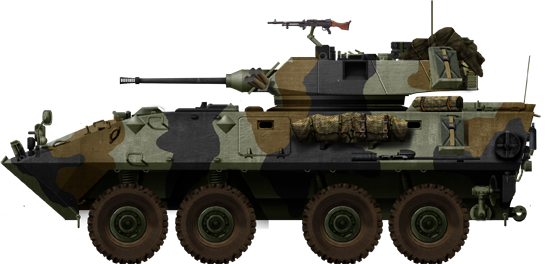
LAV-25 prototype 4-tone desert Pattern, Delta area, Marine Corps Air-Ground Combat Center, Twentynine Palms, 1982.

A Marine Corps Sikorsky CH-53E Super Stallion transports an LAV-25 as an external load froman expeditionary airfield to the Lavic Lake training area, Twentynine Palms, December 1982. One of the Marine Corps’ requirements for the LAV was that it weighs less than 16 tons in order for the vehicle to be externally lifted by helicopter.

Flying a red warning flag, an LAV-25 commander watches ashis gunner fires the vehicle’s 25mm Bushmaster chain gun on a live-fire range at Camp Pendleton, CA, 1984. The vehicle wears a distinctive fourpattern camouflage scheme. (DoD).

Marine LAV-25 crews from the 2nd LAV Battalion wait to load their vehicles onto an Air Force C-5 Galaxy at Robins Air Force Base, GA, for a flight to Marine Corps Air Station, Cherry Point, NC, March 1985.

LAV-25 in training NATO 1986.

A Marine LAV-25 seen during Joint Exercise Cold Winter 87, a NATO exercise, February 1, 1987. The turret is turned 180 degrees to face the aft end of the vehicle, and the M242 Bushmaster 25mm chain gun still has its protective cover placed over the barrel. The crew have added snow chains and a temporary coat of white paint to the NATO three-color camouflage scheme to better adapt the vehicle to its extreme environment. The vehicle displays the name “HI-BODY” on the right side of the turret. Cold weather gear, sleeping bags, rolled bed mats (known as ISO mats in the Marine Corps), and a shovel are stowed on top of the small bustle rack.

LAV-25 USMC Company A (Reinforced) 2nd LAI Batallion, Panama invasion 1989.
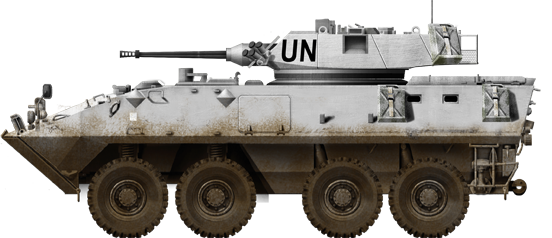
LAV-25 USMC in exercizes in Northern Europe, UN peace keeping force, Bosnia, in white washable paint livery.
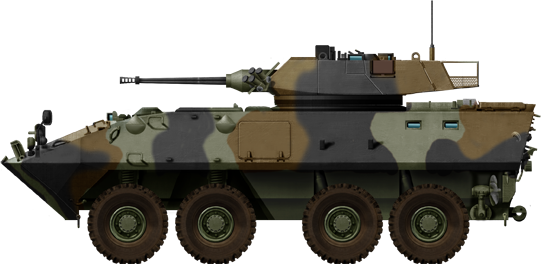
LAV-25 USMC in Saudi Arabia Operation desert storm, Gulf War 1991.
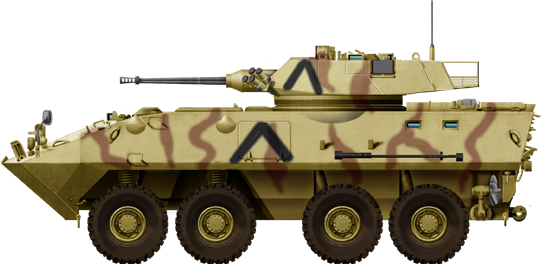
LAV-25 USMC early Gulf War 1991.

LAV-25 USMC in Saudi Arabia Operation desert storm, Gulf War 1991.
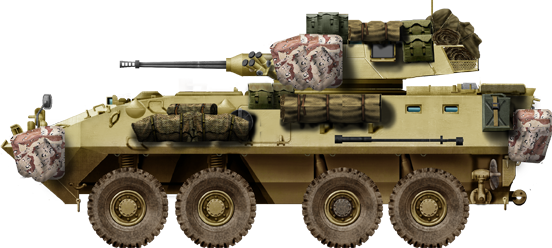
LAV-25 USMC, Modadisciu Airport, Somalia, Operation Restore Hope, 1992.
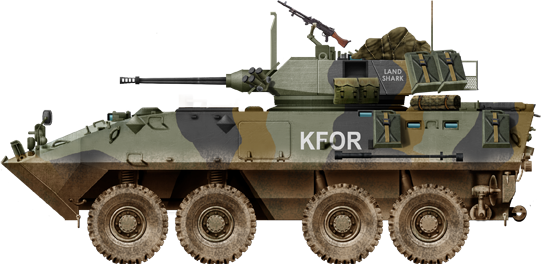
LAV-25, 2nd LAR Batallion, Zerga, Kosovo, 1999.
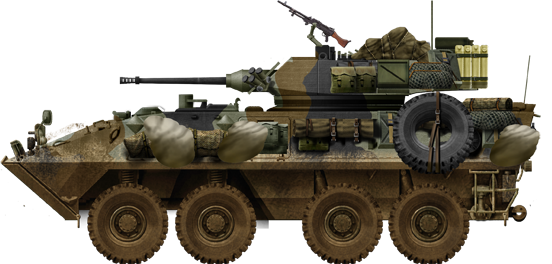
LAV-25 26 MEU, Kandahar, Afghanistan January 2002.

LAV-25 USMC Company D, 1st LAR Batallion; Iraq 2008.
Variants

LAV-L logistic vehicle

LAV-R Recovery vehicle

LAV-C2 Command vehicle
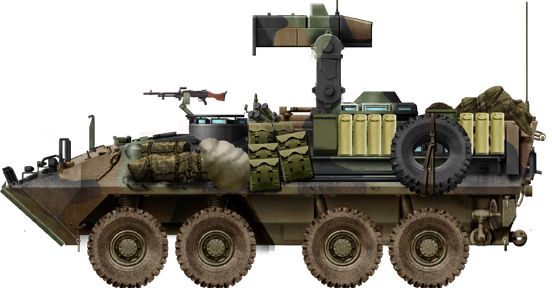
LAV-T Antitank vehicle
LAV-M Mortar vehicle
LAV-AG assault gun
LAV MEWSS electronic warfare vehicle
Upgrades
LAST/CCA Protection upgrade (1991, 1998)

SLEP vehicle in Iraq 2009

LAV-A2, 22nd MEU, Exercise Bright Star, Alexandria, Egypt, October 12, 2009
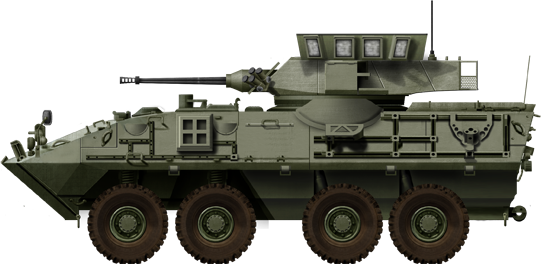
LAV-A2 4-68 Rgt, OTC, 3rd Rgt, Brig. 82 Airborne aidrop test.
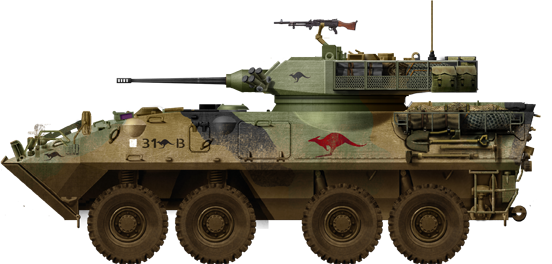
Australian ASLAV
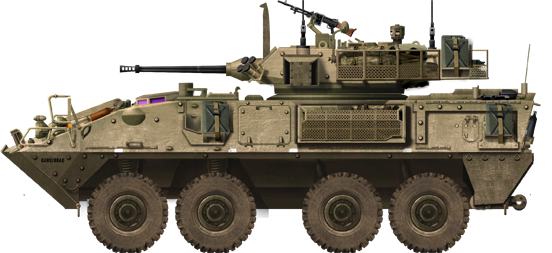
Canadian Coyote in Afghanistan 2009
 Saudi SANG (National Guard) LAV-M
Saudi SANG (National Guard) LAV-M

Cold War Tanks


































Cold war tanks posters

Cold War Main Battle Tanks

Cold War Soviet Army
Museums, Movies, Books & Games
The Tanks and Armor in pop culture
Tanks and armored vehicles in general are only really grasped when seen first person: The mass, the scale, it's all there. Explore also the way tanks were covered in the movie industry, in books and in video games.Movies:
Best tanks movie on warhistoryonline.com
On imdb.com
On bestsimilar.com/
miltours.com
liveabout.com/
watchmojo.com
Video Games:
pcgamesn.com
historyhit.com
levvvel.com
vg247.com/best-tank-games
mmobomb.com/
alienwarearena.com

